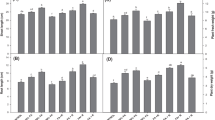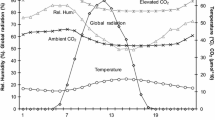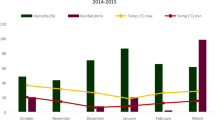Abstract
Due to the hostile conditions created by fly ash, its utilization in vegetation is restricted. Therefore, fly ash with soil amendment may offer a suitable combination to support plant growth, with reduced risk of metal toxicity. The present study evaluated different concentrations of fly ash with soil amendments on growth, photosynthesis, photosystem (PS) II activity and antioxidant defense in rice (Oryza sativa L.) seedlings to find out the optimum use of fly ash in rice cultivation. Low levels of fly ash (25%) amended soil improve the seedling growth parameters, CO2 photosynthetic rate and stomatal conductance in rice seedlings. Whereas leaf pigments and PS II activity remain unchanged under 25% fly ash treatment as compared to the plants grown in garden soil; however, these parameters declined under the treatments with higher levels of fly ash. Furthermore, the activities of some antioxidant enzymes and protein increased over control under low level of fly ash. The results showed maintenance of photosynthesis and PS II activity of rice seedlings under low levels of fly ash amendment, due to better antioxidative protection from oxidative damage. Taken together, soil amended at 25% fly ash improved the growth of rice seedlings; making fly ash a suitable component of plant growth substance. It can be concluded that a low level of fly ash can be used in amending rice soil for a short period of time but continuous use of fly ash can cause permanent soil contamination by increasing the load of toxic metals.



Similar content being viewed by others
References
Ram LC, Masto RE (2014) Fly ash for soil amelioration: a review on the influence of ash blending with inorganic and organic amendments. Earth Sci Rev 128:52–74
Verma SK, Singh K, Gupta AK, Pandey VC, Trivedi P, Verma RJ, Patra DD (2014) Aromatic grasses for phytomanagement of coal fly ash hazards. Ecol Eng 73:425–428
Pandey VC, Singh N (2010) Impact of fly ash incorporation in soil systems. Agric Ecosyst Environ 136:16–27
Padhy RN, Nayak N, Dash-mohini RR, Rath S, Sahu RK (2016) Growth, metabolism and yield of rice cultivated in soils amended with fly ash and cyanobacteria and metal loads in plant parts. Rice Sci 23(1):22–32
Mishra M, Sahu RK, Padhy RN (2007) Growth, yield and elemental status of rice (Oryza sativa) grown in fly ash amended soils. Ecotoxicology 16:271–278
Raja R, Nayak AK, Rao KS, Puree C, Shahid M, Panda BB, Kumar A, Tripathi R, Bhattacharyya P, Baig MJ, Lal B, Mohanty S, Gautam P (2014) Effect of fly ash deposition on photosynthesis, growth and yield of rice. Bull Environ Contam Toxicol 93:106–112
Sharma P, Dubey RS (2007) Involvement of oxidative stress and role of antioxidative defense system in growing rice seedlings exposed to toxic concentrations of aluminum. Plant Cell Rep 26:2027–2038
Gill M (2014) Heavy metal stress in plants: a review. Int J Adv Res 2:1043–1055
Panda D, Rao DN, Sharma SG, Strasser RJ, Sarkar RK (2006) Submergence effect on rice genotypes during seedling stage: probing of submergence driven changes of photosystem 2 by chlorophyll a fluorescence induction O-J-I-P transients. Photosynthetica 44:69–75
Reid RJ, Hayes JE, Post A, Stangoulis JCR, Graham RD (2004) A critical analysis of the causes of boron toxicity in plants. Plant Cell Environ 27:1405–1414
Gajić G, Pavlović P, Kostić O, Jarić S, ĐurĐević L, Pavlović D, Mitrović M (2013) Ecophysiological and biochemical traits of three herbaceous plants growing on the disposed coal combustion fly ash of different weathering stage. Arch Biol Sci 65:1651–1667
Sayed OH (2003) Chlorophyll fluorescence as a tool in cereal crop research. Photosynthetica 41:321–330
Maxwell K, Johnson GN (2000) Chlorophyll fluorescence practical guide. J Exp Bot 51:659–668
Bhaduri MA, Fulekar MH (2012) Antioxidant enzyme responses of plants to heavy metal stress. Rev Environ Sci Biotechnol 11:55–69
Singh OV, Labana S, Pandey G, Budhiraja R, Jain RK (2003) Phytoremediation: an overview of metallicion decontamination from soil. Appl Microbiol Biotechnol 61:405–412
Bisoi SS, Mishra SS, Barik J, Panda D (2017) Effects of different treatments of fly ash and mining soil on growth and antioxidant protection of Indian wild rice. Int J Phytoremediat 19:446–452
Porra RJ (2002) The chequered history of the development and use of simultaneous equations for accurate determination of chlorophylls a and b. Photosynth Res 73:149–156
Giannopolitis CN, Ries SK (1977) Superoxide dismutases: occurrence in higher plants. Plant Physiol 115:159–169
Choudhury SR, Choudhury MA (1985) Hydrogen peroxide metabolism as an index of water stress tolerance in jute. Physiol Plant 65:503–507
Cakmak I, Marschner H (1992) Magnessium deficiency and highlight intensity enhance activities of superoxide dismutase, ascorbate peroxidase and glutathione reductase in bean leaves. Plant Physiol 98:1222–1227
Nakano Y, Asada K (1981) Hydrogen peroxide is scavenged by ascorbate specific peroxidase in spinach chloroplasts. Plant Cell Physiol 22:867–880
Rao MV, Hale BA, Ormrod DP (1995) Amelioration of ozone-induced oxidative damage in wheat plants grown under high carbon dioxide: role of antioxidant enzymes. Plant Physiol 109:421–432
Lowry OH, Rosebrough NJ, Farr AL, Randall RJ (1951) Protein measurement with the Folin phenol reagent. J Biol Chem 193:265–275
Miteva E, Merakchiyska M (2002) Response of chloroplasts and photosynthetic mechanism of bean plants to excess arsenic in soil. Bulg J Agric Sci 8:151–156
Techer D, Laval-Gilly P, Bennasroune A, Henry S, Martinez-Chois C, D’Innocenzo M, Falla J (2012) An appraisal of Miscanthus giganteus cultivation for fly ash revegetation and soil restoration. Ind Crop Prod 36:427–433
Kostić O, Mitrović M, Knežević M, Jarić S, Gajić G, Djurdjević L, Pavlović P (2012) The potential of four woody species for the revegetation of fly ash deposits from the “Nikola Tesla –A” thermoelectric plant (Obrenovac serbia). Arch Biol Sci 64:145–158
Calatayud A, Roca D, Martínez PF (2006) Spatial-temporal variations in rose leaves under water stress conditions studied by chlorophyll fluorescence imaging. Plant Physiol Biochem 44:564–573
Pinnola A, Dall’Osto L, Gerotto C, Morosinotto T, Bassi R, Alboresi A (2013) Zeaxanthin binds to light-harvesting complex stress-related protein to enhance nonphotochemical quenching in Physcomitrella patens. Plant Cell 25:3519–3534
Arora A, Sairam RK, Srivastava GC (2002) Oxidative stress and antioxidative system in plants. Curr Sci 82:1227–1238
Rastgoo L, Alemzadeh A (2011) Biochemical responses of Gouan (Aeluropus littoralis) to heavy metals stress. Aust J Crop Sci 5:375–383
Acknowledgements
The authors are grateful to Dr. S. K. Palita, Head, Department of Biodiversity and Conservation of Natural Resources for providing necessary facilities for the work. The Director, NRRI, Cuttack is highly acknowledged for providing the rice seeds.
Author information
Authors and Affiliations
Corresponding author
Ethics declarations
Conflict of interest
The authors declare that there is no conflict of interest to publish this manuscript.
Additional information
Significance statement The study showed that the fly ash-amended soil in low concentration (25%) could be beneficial in rice seedling as it improves growth and photosynthesis. The finding is encouraging for an agro-friendly use of low levels of fly ash (25%) in agriculture as a soil amendment.
Electronic Supplementary Material
Below is the link to the electronic supplementary material.
Rights and permissions
About this article
Cite this article
Panda, D., Mandal, L., Barik, J. et al. Improvement of Growth, Photosynthesis and Antioxidant Defense in Rice (Oryza sativa L.) Grown in Fly Ash-Amended Soil. Proc. Natl. Acad. Sci., India, Sect. B Biol. Sci. 89, 853–860 (2019). https://doi.org/10.1007/s40011-018-0996-7
Received:
Revised:
Accepted:
Published:
Issue Date:
DOI: https://doi.org/10.1007/s40011-018-0996-7




